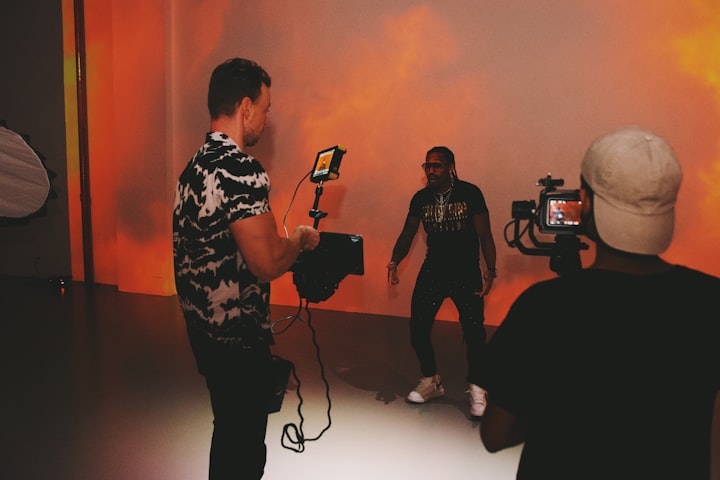Why fake punches in movies looks so real
"Unveiling the Illusion: The Secrets Behind Convincingly Fake Punches in Movies and the Art of Making Fake Punches Look Real in Movies"

The other day, I had the opportunity to watch the movie "Shang-Chi," and I was truly captivated by the exhilarating fight sequence that took place on the bus. What amazed me the most was how the filmmakers were able to create such a visceral and authentic experience without causing any harm to the actors or crew involved. While I understand that the punches and kicks were not real, they were executed in a way that made them feel incredibly genuine. This left me curious about the techniques used to achieve such a convincing portrayal. Being a second unit director and stunt coordinator myself, I decided to reach out and inquire about the behind-the-scenes process. Wade Eastwood, a highly skilled professional in the world of action movies, is the individual responsible for the impressive stunts in "Shang-Chi" and other notable films from the past decade. It's important to note that Wade Eastwood is not related to other well-known Hollywood figures with a similar last name. One of his notable appearances was in the 2008 film "Quantum of Solace," where he served as Daniel Craig's stunt double. However, before Wade even sets foot on the movie set, he and his team engage in extensive preparation and pre-visualization. You might be familiar with VFX pre-vis, which Marvel is known for, where low-fidelity animations are created prior to filming. In addition to that, stunt teams often utilize what I refer to as "action vis." This involves capturing live footage using the appropriate cameras to accurately depict the action sequences.
In the process of creating action vis, the approach often involves using makeshift sets made of boxes, and stuntmen take on the lead roles. This allows them to carefully choreograph the action sequences and determine the optimal camera angles within a safe environment. When it's time to film the actual movie, the main unit focuses on shooting the dramatic and acting scenes, while the specialized unit, led by Wade Eastwood in this case, takes charge of capturing all the action sequences.
To analyze a fight scene at its most fundamental level, let's consider a punch. The key to delivering a convincing punch lies in the collaboration between both parties involved—the A-side and the B-side. If the person throwing the stunt punch executes it with exceptional movement and performance, but the person receiving the punch reacts in a lackluster manner, the impact falls flat. It is essential for both parties to give their utmost effort, committing fully to their roles in order to create a believable and impactful scene.
One crucial aspect to consider is that during action sequences, the actors and stunt performers usually do not actually make physical contact with each other. This can sometimes result in a fake-looking fight if proper techniques aren't employed, such as "stacking the action." This industry term refers to the method of layering the movements and positioning of the individuals involved in a way that tricks the camera. Without stacking the action, the distance between the performers becomes apparent and the impact loses its believability. By strategically positioning the camera and adjusting the gaps, typically just a few inches or up to a foot, the illusion of a close interaction can be created.
However, there are instances, as explained by Michael B. Jordan on the Graham Norton Show, where actual contact may be necessary to sell a scene, particularly when it's filmed in slow motion. In these cases, faking the impact would be noticeable due to the visible space between the performers. The recipient of the hit, known as the B side, plays a crucial role in selling the force of the punch. A small hit may elicit a minimal reaction, while a more significant impact can lead to a dramatic fall, making it appear more powerful. Safely executing falls is a skill in itself, where the body absorbs the impact gradually, with different body parts taking on the force incrementally.
Similar considerations apply to other actions, such as big car crashes. Kinetic energy must be dispersed throughout the movement to prevent extreme impact. Stopping abruptly, like a car hitting a wall, would be catastrophic. Falling correctly involves absorbing just enough impact to make it look intense without risking severe injury. Often, strategically concealed padding is used to mitigate potential harm. The padding can be disguised as different materials like wood or concrete, allowing performers to hit with greater force and take multiple takes while maintaining their safety. Occasionally, minor injuries like bruises or strained muscles may still occur despite precautions.
Furthermore, in post-production, additional tricks are employed to enhance the impact of the hits. By cutting frames where the fist is supposed to make contact, the viewer's brain fills in the gap, creating the perception of a more powerful strike.
Through these techniques, both on set and in post-production, the audience is immersed in the illusion of hard-hitting action, while the safety of the performers is prioritized.
An effective trick utilizing visual effects can be observed in a particular shot from "Shang-Chi," where Simu Liu's elbow visibly pops on impact. Additionally, certain movies employ a technique, not used in this instance, where the visual effects team extends the fist digitally to create the illusion of direct contact with the face. A notable example of this can be seen in a clip from "No Time to Die," where Ana de Armas' digital legs were added, and the stunt performer was slightly pulled in closer to enhance the impact. Sound design in fight scenes also plays a crucial role in providing clarity, indicating whether a swing misses or connects with force.
The absence of sound in a scene would diminish the audience's ability to perceive the impact of a blocked kick, the intensity of a bone-crushing punch, or the softening effect of a defensive maneuver. However, regardless of how visually impressive a fight may appear, its excitement can be diminished if there are no stakes involved. While films like the Avengers series are loved, certain scenes where the heroes effortlessly defeat hordes of adversaries can lose some of their impact.
By incorporating techniques such as visual effects, sound design, and establishing high stakes, fight scenes can captivate the audience and heighten their engagement with the action on screen.
There are instances in films like "Back to the Future" where the entire plot builds up to a pivotal punch that alters the course of history. These fights, which serve as great spectacles, exist in various movies. However, it is important to note that fights without a clear purpose or meaningful context may lack substance. A fight becomes truly exciting when it is embedded within a proper narrative, carrying emotional weight and taking the audience on a journey. This is when a fight truly captivates viewers and evokes excitement.
It is worth mentioning that in my previous response, I inadvertently mixed in some personal commentary. I apologize for any confusion caused by the inclusion of unrelated statements. Thank you for your understanding.
About the Creator
Imoka Asika Paul
Experienced, organized and dependable candidate successful at managing multiple priorities and with a positive attitude has accurately contributed to over a dozen projects with a fast-paced working conditions






Comments
There are no comments for this story
Be the first to respond and start the conversation.